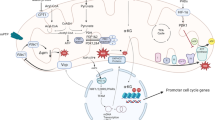Summary
Heart tissue contains appreciable amounts of fatty acid-binding protein (FABP). FABP is thought to play a crucial role in the transport of fatty acids from the cellular membrane to the intracellular site of oxidation and also, in case of endothelial cells, in the transfer of fatty acids from the vascular to the interstitial compartment through the endothelial cytoplasm. The present study was designed to delineate a possible quantitative relationship between the capacity of different cell types in the heart to oxidize fatty acids and the presence of FABP. Palmitate oxidation capacity, measured in homogenates of cells isolated from adult rat hearts, was 2 nmol/min per mg tissue protein in freshly isolated cardiomyocytes (CMC), but only 0.09 and 0.31 nmol/min per mg tissue protein in cultivated endothelial (CEC) and fibroblast-like cells (CFLC), respectively. Palmitate oxidation rates were closely related to the cytochrome C oxidase activity and, hence, to the mitochondrial density in the cells under investigation. In CMC the content of cytosolic H-FABP (H-FABPc) was about 4.51 µg/mg tissue protein. However, in CEC and CFLC the FABP content was less than 0.01 and 0.004 µg/mg tissue protein, respectively, corresponding to at maximum 0.2% of the FABP content of CMC. These findings indicate a marked difference between CMC and non-myocytal cells in the heart regarding their capacity to oxidize fatty acids, and a marked disproportion between the fatty acid oxidation capacity and immunochemically determined FABP content in both CEC and CFLC. The functional implication of these observations remains to be elucidated.
Similar content being viewed by others
References
Neely JR, Rovetti MJ, Oram JF: Myocardial utilization of carbohydrate and lipids. Prog Cardiov Dis 15: 289–329, 1972
Spahr R, Krützfeldt A, Mertens S, Siegmund B, Piper HM: Fatty acids are not an importanf fuel for coronary microvascular cells. Mol Cell Biochem 88: 59–64, 1989
Bassingthwaighte JB, Noodleman L, van der Vusse G, Glatz JFC: Modeling of palmitate transport in the heart. Mol Cell Biochem 88: 45–49, 1989
Van der Vusse GJ, Prinzen FW, VanBilsen M, Engels W, Reneman RS: Accumulation of lipids and lipid-intermediates in the heart during ischaemia. Basic Res Cardiol 82 (suppl 1): 157–167, 1987
Van der Vusse GJ, Glatz JFC, Stam HCG: Myocardial fatty acid homeostasis. Mol Cell Biochem 88: 1–6, 1989
Bass NM: The cellular fatty acid binding proteins: aspects of structure, regulation and function. Int Rev Cytol 111: 143–184, 1988
Glatz JFC, van der Vusse GJ: Intracellular transport of lipids. Mol Cell Biochem 88: 37–44, 1989
Glatz JFC, Baerwaldt CCF, Veerkamp JH, Kempen HJM: Diurnal variation of cytosolic fatty acid-binding protein content and of palmitate oxidation in rat liver and heart. J Biol Chem 25: 4295–4300, 1984
Crisman TS, Claffey KP, Saouaf R, Hanspal J, Brecher P: Measurement of rat heart fatty acid binding protein by ELISA. Tissue distribution, developmental changes and subcellular distribution. J Mol Cell Card 19: 423–431, 1987
Fournier NW, Rahim M: Control of energy production in the heart: a new function for fatty acid binding protein. Biochem 24: 2387–2396, 1985
Börchers T, Unterberg C, Riidel H, Robenek H, Spener F: Subcellular distribution of cardiac fatty acid-binding protein in bovine heart muscle and quantification with an enzyme-linked immunosorbent assay. Biochim Biophys Acta 1002: 54–61, 1989
Piper HM, Probst I, Schwartz P, Hiitter FJ, Spieckermann PG: Culturing of calcium stable adult cardiac myocytes. J Moll Cell Card 14: 397–412, 1982
Diglio CA, Grammas P, Giacomelli F, Wiener J: Rat heart-derived endothelial and smooth muscle cell cultures: isolation, cloning and characterization. Tiss Cell 20: 477–492, 1988
Maciag T, Cerundolo J, Ilsley S, Kelley PR, Foriand R: An endothelial cell growth factor from bovine hypothalamus. Proc Nat Acad Sci USA 76: 5674–5678, 1979
Voyta JC, Via DP, Butterfield CE, Zetter BR: Identification and isolation of endothelial cells based on their increased uptake of acetylated-low density lipoprotein. J Cell Biol 99: 2034–2040, 1984
Laurila P, Virtanen I, Wartiovaara J, Stanman S: Fluorescent antibodies and lectins strain intracellular structures in fixed cells treated with nonionic detergent. J Histochem Cytochem 26: 251–257, 1978
Jaffe EA, Hoyer LW, Nachman RL: Synthesis of Von Willebrand factor by cultured human endothelial cells. Proc Natl Acad Sci USA 71: 1906–1909, 1974
Glatz JFC, Veerkamp JH: Postnatal development of palmitate oxidation and mitochondrial enzyme activities in rat cardiac and skeletal muscle. Biochim Biophys Acta 711: 327–335, 1982
Lowry OH, Rosebrough NJ, Farr AL, Randall RJ: Protein measurement with the folin phenol reagent. J Biol Chem 193: 265–275, 1951
Gohil K, Jones DA, Edwards RHT: Analysis of muscle mitochondrial function with techniques applicable to needle biopsy samples. Clin Physiol 1: 195–207, 1981
Author information
Authors and Affiliations
Rights and permissions
About this article
Cite this article
Linssen, M.C.J.G., Vork, M.M., de Jong, Y.F. et al. Fatty acid oxidation capacity and fatty acid-binding protein content of different cell types isolated from rat heart. Mol Cell Biochem 98, 19–25 (1990). https://doi.org/10.1007/BF00231363
Issue Date:
DOI: https://doi.org/10.1007/BF00231363




